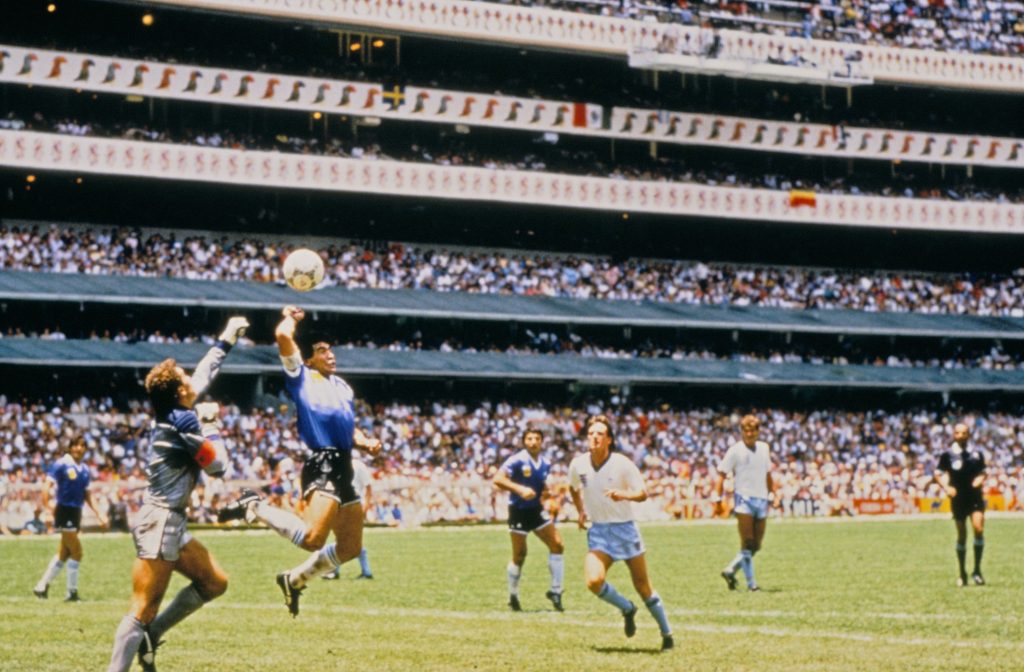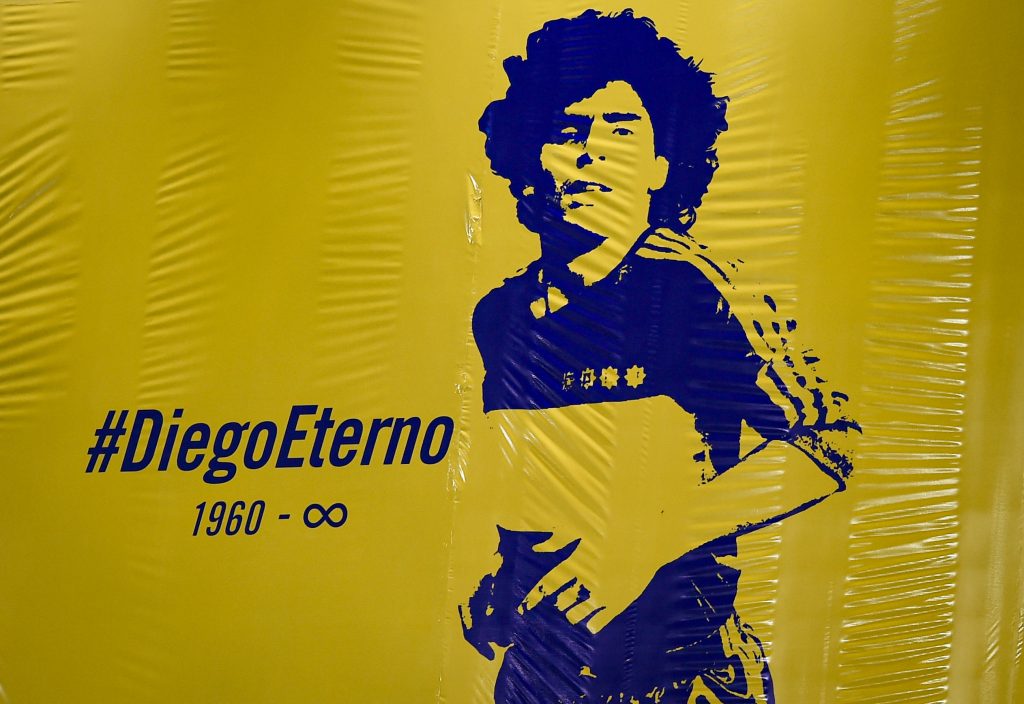
Having been brought up in a family with one part of it having British ancestry (my father’s), I developed a fondness for English football (the child in me), very difficult to banish later on in years as I began to have strong left wing political leanings and a postcolonial politics.
As a result, my feeling with regard to the soccer genius that was Diego Armando Maradona was one of love and hatred – a love-hate relationship.
I could not bring myself to forgive him for the travesty of his ‘hand of God’ goal against England in the Mexico 1986 World Cup finals but was always in awe of his sublime soccer skills which seemed to know no limits.
This was clearly demonstrated by the second goal of the same match when he ran from halfway line past a number of flummoxed English players he left for dead (the goal of the century). I was as in awe of him as I had been with regard to George Best, Johann Cruyff and nowadays Lionel Messi.
Not so long ago, people were referring to Messi as the greatest player of all time. Now soon after Maradona’s death through a heart attack at 60 they are saying this about el pibe d’oro (The Golden kid).
To be fair they had been saying this for quite a while, also in the context of the traditional Brazilian and Argentinian rivalry: Pele or Maradona? It is difficult to compare players of different eras. I am simply grateful to have seen all of them play (Pele, Best, Cruyff, Maradona, Cristiano, Messi…), though Pele mostly in 1970 and inside the same arena where Maradona would, 16 years later, have his consecration as the world’s then greatest soccer icon.
Pele was surrounded by an array of great midfielders and forwards besides a marauding world class full back. Maradona had good but not great players surrounding him save for a Jorge Valdano and a Jorge Burruchaga. Maradona, however, represented the subaltern hero par excellence.
He played with the skills of a unique talent, skills that only a few players can put on display. This was evident from his earlier years with Argentinos Juniors and when he burst onto the international stage in Japan in the 1979 Coca-Cola World Youth Championship which Argentina won beating the USSR in the final.

Italian commentators referred to this stocky youth as ‘l’astro nascente’ (prodigy, a young man of tremendous promise). I recall seeing him score a goal of exquisite beauty for Argentina against a Rest of the World XI to commemorate one year since Argentina’s 1978 World Cup win.
These are skills that place him in the same bracket as such other Argentinian greats as Alfredo di Stefano (la saeta rubia), Lionel Messi and perhaps Omar Sivori.
Unlike the contemporary Messi, he was both a leader and the street urchin (scugnizzi they call them in Naples) who would ally mesmerising skills with his questionable arts of hoodwinking referees with quick thinking and guile.
The ‘Hand of God’ goal in 1986 was a classic example. He also has the wits of the street urchin.
Who can forget how he played on the traditional North-South divide of Italian post-Risorgimento politics, known as ‘La Questione Meridionale’? With the 1990 World Cup semi-final being staged in Naples, the city where he played his club football, taking Naples, just as he single-handedly took an otherwise modest Argentinean XI, to international heights, he cleverly stirred Neapolitan feelings.
“For 364 days you do not consider Naples as Italian,” he quipped to this effect
“Now for just one day you want Neapolitans to be Italian”.
Maybe the minds of Neapolitans would have already been made up by then. It is well known that Maradona had become such a cult figure in Naples that several Neapolitans inside the Stadio San Paolo (soon to be named after Maradona) rooted for their hero’s Argentina.
Argentina went through on penalties and so, four years on from his 1986 success, Diego steered the blue and white stripes to another World Cup final against West Germany.
But Italians are an unforgiving lot. Any team playing Argentina in the final, and that could have been England who also lost their semi-final on penalties, would have had a hostile Italian home crowd rooting for them or rather baying for Maradona’s and Argentinean blood.

He was given the treatment in Rome said to have been meted out to the Early Christians when thrown to the lions inside the Colosseum. Argentina lost the contest to a dubious penalty and had players sent off.
Being, however, the subaltern hero par excellence, Diego Armando Maradona, born in one of the poorer quarters of Buenos Aires, found in Naples, with its impoverished quarters and Hispanic residues (it had been under Spanish control before the Risorgimento and some people felt that they were treated better by the Bourbons than by the so-called Northern liberators), the ideal environment for cult hero status.
One would argue that with his sublime almost extra-terrestial skills he would have been a demigod anywhere. Well, it would have been difficult for him to have the same status with his previous European club, Barcelona.
Neither Messi would be that cult status figure, despite leading them to four Champions League titles and numerous La Liga (Spanish league championship) victories.
That role was secured by the great Johann Cruyff, the star of the 1974 World Cup and of the Ajax team which won three European Cups, who, after moving to Barca, took them from mid-table mediocrity, to the sunlit uplands of Spanish football both as player and later manager; he won them their first ever European cup.
Furthermore, he set them a style which has become their trademark ever since. He argued “If the opponents do not have the ball, they cannot score.” This is possession football at its most scintillating, tiki-taka, or simply the Johann Cruyff style. So, an icon already existed in Catalan folklore, especially as far as Cruyff as player was concerned; his managerial successes came during the twilight of and after Maradona’s stint in Naples.
Maradona however fit Naples to a tee. He took the city’s football team to heights hardly envisioned previously. The club had good Fairs Cup and UEFA Cup runs but never went as far as to win the competition, let alone the Italian league.
Under Maradona, they won the UEFA Cup and two scudettos (Italian league championships). Unlike Argentina, the club surrounded him with great players, from the locals (Naples always produced good players) Ciro Ferrara and Fernando Di Napoli, to the Brazilians, Alemao and Careca.
Maradona put Naples on the map thus becoming the greatest imported ‘Neapolitan’ fit to flank such key city emblems as the comedian Toto’, the great Caruso, St Januarius (San Gennà, short for San Gennaro, the city’s patron saint) and Edoardo De Filippo (the city’s greatest playwright).
He fit the scugnizzo image, the street urchin and his image is found in restaurants all over the city and in niches/triumphs along the narrow streets of Naples, such as the famous Quartieri Spagnoli (Spanish quarters)
Maradona would fit one of the figures of poverty and living by the wits typical of the style of 17th century painting called ‘Neapolitan’, foremost among its exponents being another Hispanic, Jusepe de Ribera, lo spagnoletto, from Xativa.
El pibe would fit these scenes and those of the Lazzaroni. He would also resemble somebody in the retinue of characters in a De Filippo play.
Of all the great goals he scored in his career for Argentina and Naples, one goal stands out in the Neapolitan psyche. It was certainly on view in 1997, well after Maradona had left Napoli, outside the San Paolo stadium.
I watched a Napoli, fallen on hard times, take on high flying Inter, a Sud-Nord contest full of political significance. It was not the wonder goals they showed over and over again, including the superlative effort and virtuosity against England, but the ‘Hand of God’ goal. This was as if to say: this is the way many survive in this subaltern city where poverty, crime and unemployment (in the formal economy) prevail.
If you cannot score with your hands, i.e. live by your wits and guile, you are a ‘dead duck’, as they say in North America. Maradona symbolised this. He bestrode the different Neapolitan worlds, the world of the spectacle and the underworld.
Treachery and creativity in chaos are part and parcel of a city which the great local musician, Pino Daniele, called ‘Napule mille colori’(Naples a thousand colours).
Maradona added substantially to Naples’ unique kaleidoscope of colours. And the poignancy of his role as a hero in places of subalternity was not lost on him. He often expressed what would-be right-wing views in his earlier days.
His period of rehabilitation against drug and alcohol addiction, his nadir which accompanied his apotheosis in Naples, and which shortened his life, led to the turning of his head towards the Left.
Cuba, Castro and the ghost of fellow Argentinian, Ernesto ‘Che’ Guevara, must have had a telling effect on Maradona. He became a strong advocate of left-wing politics.
Referring to Che as the greatest Argentinean (he sported his tattoo on his arm), he appeared on Italian TV alongside his friend and Latin American connoisseur, Gianni Mina’, discussing issues of political dependency and neo-colonialism.
A staunch defender and advocator of the Cuban revolution, he provided a very revealing and detailed article on Castro following the jefe’s death in 2016, highlighting the achievements in health, education and sustainable development of the Cuban revolution.
This too was Maradona, more in keeping with his image of the subaltern hero.
May he rest in peace.

World Cup News
-


FIFA World Cup
/ 1 week agoUruguay end winless run with dramatic late win over Colombia
Manuel Ugarte grabbed a dramatic last-gasp winner as Uruguay ended a five-match winless streak...
By AFP -


FIFA World Cup
/ 1 week agoArgentina fall in Paraguay, Brazil held in Venezuela
World champions Argentina suffered a 2-1 defeat to Paraguay while rivals Brazil were held...
By AFP -


FIFA World Cup
/ 1 month agoLenovo become FIFA’s World Cup ‘technology partner’
Chinese technology company Lenovo have signed a sponsorship deal with FIFA that covers the...
By AFP -


FIFA World Cup
/ 3 months agoVinicius says Spain should lose 2030 World Cup unless racism declines
Brazilian striker Vinicius Junior has called for Spain to be stripped of its 2030...
By AFP

English football
Spurs thrash Man. City 4-0 to end 52-match unbeaten home run

360 Sports Malta Premier
Sliema Wanderers ease past Hibernians to keep pressure on league pacesetters

More sports
Andy Murray to coach Novak Djokovic

English football
Arsenal back to winning ways, Chelsea up to third in Premier League

360 Sports Malta Premier
Ħamrun Spartans stun Birkirkara as Floriana bridge gap afer dramatic win





























